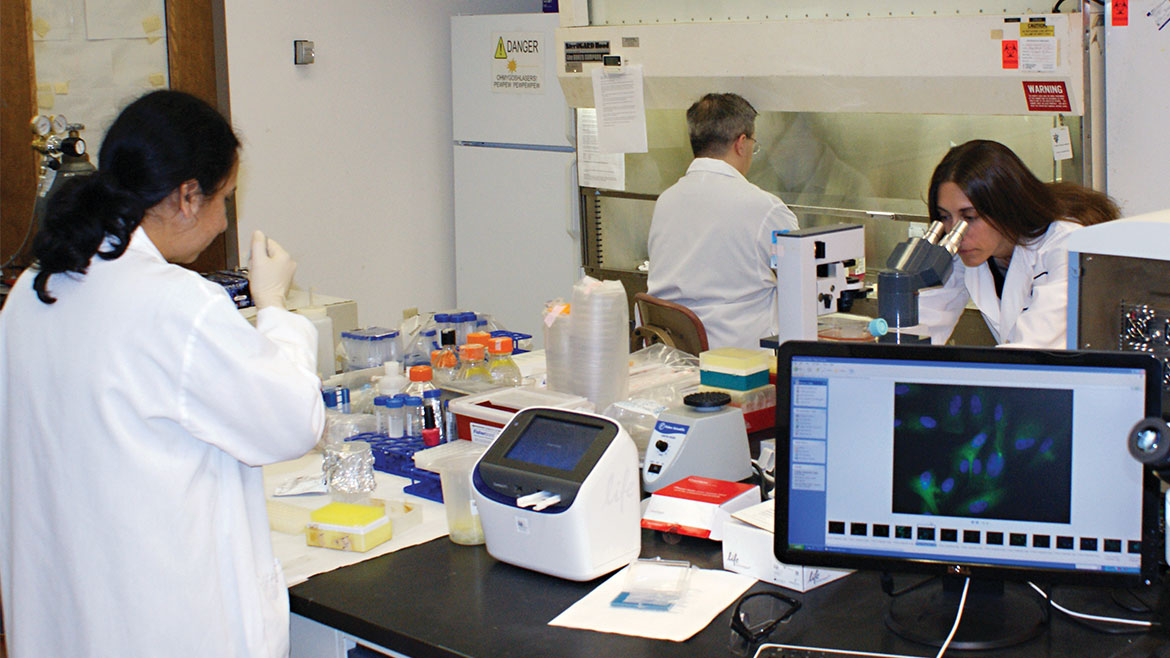How to Save a Life: Cancer Research Center

Last year, Missouri had over 34,000 new cancer cases. That’s roughly the population of Moberly and Sedalia combined.
Cancer Research Center was founded in 1962 to create a better future for cancer patients. Since then, CRC has dedicated its time to identifying ways to detect cancer early, create innovative therapies, and analyze tumor reduction factors.
“We work on getting humanity to the point where cancer becomes a disease you can treat,” says senior investigator Dr. Robert A. Kazmierczak, “something you can live with and still live your full lifespan with a high quality of life.”
New Findings
Chemotherapy. Radiation therapy. Hair loss. Sores. Cancer patients seeking treatment go through hours of therapy that results in pain, emotionally and physically. Some of CRC’s recent work involves a breakthrough therapy involving an unlikely component: salmonella.
Yes, it’s most commonly found in raw meat and is usually dangerous to consume, but for cancer patients, it could be a revitalizing therapy.
The salmonella strain, CRC 2631, is a targeted cancer therapy that can treat a multitude of cancers. In 2005, senior technician and laboratory manager Alison Dino began working with an archival strain of salmonella that had been brought to CRC from the Carnegie Institution for Science by Dr. Abraham Eisenstark. Building on past research, Dino took the bacteria and put it in a dish with cancer cells. Within half an hour, CRC 2631 had moved to the cancer cells and surrounded them.
“It was a really neat ‘Eureka!’ moment,” Dino says.
When the CRC 2631 bacteria enters the body, it locates the cancer area and disrupts tumors, keeping them from becoming malignant. (It’s non-toxic to normal cells.) By using the circulatory system, CRC 2631 not only targets the primary area, but could also target any possible secondary cancer areas. This discovery has allowed for maximum effectiveness with minimal harsh side effects. The federal government has recognized and patented the Salmonella strain to CRC.
“My favorite part of this job is being able to come in the lab, do an experiment and see an exciting result and go, ‘OK. I am the only person in the world that knows this right now,’” Kazmierczak says.
Time Management
Time is of the essence in fighting cancer. One of the first things that Kazmierczak did when he joined the team in 2005 was save time in tracking CRC 2631. He made the bacteria shine a red or green fluorescent color to be more easily recognizable. He also further engineered the strain to improve its non-toxicity and better target and destroy cancer cells.
Other CRC efficiency efforts have come in many forms — human or, sometimes, machine. Dr. Bakul Dhagat Mehta, the CRC’s Raymond W. Freese Fellow, is currently working on a project measuring the rate at which salmonella kills cancers, which calls for counting cells. Before, the process would be done by the researcher or, in some cases, a hired individual. But with the support from donors, CRC was able to purchase a cell counter machine that is faster and more accurate than a human — compare two hours to 10 minutes.

The CRC doesn’t have federal or state funding. Instead, they rely on fundraisers, donations from the public, and grants. Donors come from all across the country. The annual Jim Kidwell Memorial Gala is CRC’s signature fundraiser; however, Kazmierczak said he spends about a quarter of his time researching funding and applying for grants.
For the Future
Despite the team’s exciting accomplishments so far, there are still obstacles to overcome.
Since there’s not federal or state financial support, finding donors to help fund more personnel and resources can be pivotal. Researchers work on finding which areas funders are most comfortable with donating money; many times, it’s towards equipment. And people want to see the research be proven before they donate, Kazmierczak says. The CRC hopes that, with the exciting results of CRC 2631, funders will jump on board faster.
On top of funding issues, the team also must navigate the complicated regulatory path to continue their research, particularly on CRC 2631. To do so, they need to abide by FDA protocol for a clinical trial, which includes studies in mammals. The team is working on obtaining three generations of mice (who are treated “better than MU freshmen,” given the required protocol for testing on animals, administrative director Marnie Clark joked) for the next round of research, which will be conducted from January to April of 2018.
Until the FDA approval, CRC is working with the MU medical school to gather data, and they’re applying to test on larger mammals, like dogs whose owners have exhausted other treatment options.
Planning for these experiments takes months of prior preparation. Kazmierczak says he’s made checking on the mice at the MU vet school part of his work routine.
It’s easy for the team to stay motivated.
“I love that I come in and know what I’m doing will help humanity,” Dhagat says. “You get up and you’re excited to be here because you know you will be doing something worthwhile.”
Cancer Research Center
Researchers
Dr. Abraham Eisenstark – Research Director Emeritus
Dr. Chiswili Yves Chabu – Research Director
Dr. Robert A. Kazmierczak – Senior Investigator
Alison Dino – Senior Technician and Laboratory Manager
Dr. Bakul Dhagat Mehta – Raymond W. Freese Fellow
Recognition
147 media outlets covered the CRC 2631 press release (148, if you include this one).
Board of Trustees
Stephen Lee, President
Garry Banks, Vice President
David Keller, Secretary
Charlotte Acton
Burleigh Arnold
Bob Basore
Travis Burnett
James Cherrington
Tim Crockett
Sally Estes
Joel Kaplan
David Lafrenz
Sara LeMone
John McEntire


